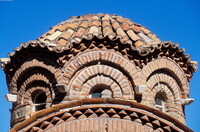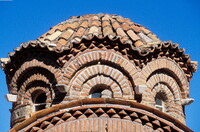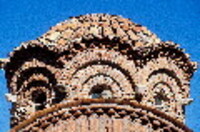| dc.coverage.spatial | Site: Mistrás, Peloponnese, Greece | en_US |
| dc.coverage.temporal | 1350-1365 (creation) | en_US |
| dc.creator | unknown (Greek (modern)) | en_US |
| dc.date | 1350-1365 | en_US |
| dc.date.accessioned | 2013-02-22T21:16:37Z | |
| dc.date.available | 2013-02-22T21:16:37Z | |
| dc.date.issued | 1350-1365 | en_US |
| dc.identifier | 195609 | en_US |
| dc.identifier.other | archrefid: 1507 | en_US |
| dc.identifier.uri | http://hdl.handle.net/1721.3/103131 | |
| dc.description | The drum and dome; This simple two-column cross-in-square church (1350-1365) has a two-storey narthex and lies to the west of the palace. It served as both the palace chapel and the katholikon of a small monastery associated with the first despot, Manuel Kantakouzenos. From the few remaining fragments of wall painting it is possible to reconstruct an iconographic programme comparable to that of the Peribleptos. A Christ Enthroned, eucharistic scenes, the Ascension and bishops are depicted in the sanctuary. A zone (h. 1.5 m) of painted decoration imitating marble revetment covers the lower part of the walls. In the nave, scenes of the Dodekaeorton and the Passion are preserved. Stylistically, the paintings are similar to those in the Peribleptos, both decorations belonging to the third quarter of the 14th century. Source: Grove Art Online; http://www.oxfordartonline.com/ (accessed 7/17/2008) | en_US |
| dc.format.medium | stone; terra cotta | en_US |
| dc.rights | © Scott Gilchrist, Archivision, Inc. | en_US |
| dc.subject | architectural exteriors | en_US |
| dc.subject | New Testament | en_US |
| dc.subject | Byzantine | en_US |
| dc.title | Mystras: Hagia Sophia | en_US |
| dc.title.alternative | Hagia Sophia | en_US |
| dc.type | image | en_US |
| dc.rights.access | Licensed for educational and research use by the MIT community only | en_US |
| dc.identifier.vendorcode | 1A3-B-G-M-10-B5 | en_US |
| vra.culturalContext | Greek (modern) Byzantine | en_US |
| vra.technique | construction (assembling) | en_US |
| vra.worktype | church | en_US |
| dc.contributor.display | unknown (Greek (modern)) | en_US |



